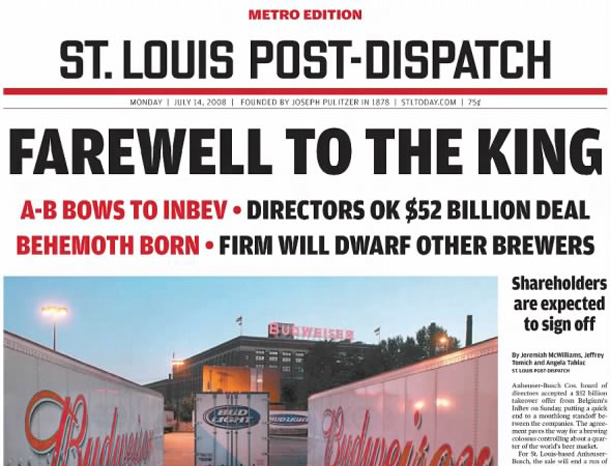BEER AND WINE LINKS, MUSING 07.16.18

A decade after Anheuser-Busch’s sale, beer still pours from St. Louis brewery but much has changed.
Beer in America changed, July 13, 2008, when Anheuser-Busch agreed to a takeover from InBev. Before getting to the “what ifs” there is this new story, one published when the deal was finalized, and one that tracks how the story played out on the front pages.
At the time, columnist Bill McClellan asked, “If the brewery is sold, how will we know who we are?”
I remember interviewing a man who had just been fired from some dead-end job. I asked about his background. “My parents were both bottlers at the brewery,” he said. I said something to the effect that those were pretty good jobs. He nodded. “But I wasn’t raised to think I was better than anybody else,” he said.
If you’re not from St. Louis — or haven’t spent years here — that might seem like a strange thing to say. Why would the child of blue-collar workers even think of saying such a thing? But if you’re from here, you understand. Brewery jobs have always been special.
The deal almost didn’t happen. (See Dethroning the King for details.) Three years later Anheuser-Busch bought Goose Island. A-B already owned a good chunk of the brewery and Goose Island founder John Hall was looking for a buyer. (See Barrel-Aged Stout and Selling Out for details.) Does that guarantee that A-B would have struck the deal were it still independent itself? And had that purchase not led to a buying spree the swept up Elysian, Wicked Weed, etc. how might this chart Michael Tonsmeire posted on Twitter look different?

As you can see it generated plenty of comments, leading him to update it Monday.
What “Cræft” Can Teach Us About Beer.
Jeff Alworth tweeted that this post is underperforming. I have no idea if summer heat is to blame or if the beer crowd has grown so weary of the discussion that their eyes glaze over when the words craft and beer or put together. But that is too bad, because Alexander Langlands’ book is relevant to this conversation that will not go away. I guess this is “what if” Monday because I am wondering what if Vince Cottone had used terms other than craft brewery and craft brewing in 1984. Wait, he did. It just didn’t catch on. In 1986 Cottone provided a definition for what he called True Beer, calling it “the ideal, uncompromised beer, beer that’s hand-made locally in small batches using quality natural ingredients, served on draft fresh and unpasteurized. It’s not a new kind of beer, even in North America.”
Not a Face in the Crowd — Wave of Beer Festivals Focus on Women, People of Color.
Mark Aug. 11 on your calendar. The news gives me an excuse to pass along something I’ve meant to since early May. There were three panel discussions during a North American Guild of Beer Writers meeting on the last day of the Craft Brewers Conference in Nashville. Julie Verratti, co-founder of Denizens Brewing Co. and chair of the Brewers Association’s diversity committee, pointed out during one of those that diversity should include what beers are on offer. A brewery or bar that fills every one of them with basically the same beer — be it light lager or IPA — is sending a different message than one that welcomes customers with a range of flavors.
How the Birthplace of the Atomic Bomb Sparked an Unlikely Beer Scene.
The Community Is Real, Even if You Don’t Go to the Meetings.
I pointed to Boak & Bailey’s post on Friday during a quick discussion about community. The story about Los Alamos reminded me of what would have made a perfect addition. In 2000, a fire leveled 400 homes in Los Alamos, forced all 18,000 residents to be evacuated and closed the Los Alamos National Laboratory for two weeks. As news spread that three members of the local homebrew club, the Atom Mashers, lost their homes and another a storage shed, donations poured in. Manufacturers and suppliers shipped equipment and ingredients, while members of other homebrew clubs sent cash.
WINE
VinoVip al Forte: Money, Taste, & the Future of the Italian Wine Industry.
The flip suggestion would be to replace “Italian wine” with German beer” in this sentence “What’s holding back the Italian wine industry and how can it change to be more successful in the hyper-competitive global market environment?” But fair? You decide.
FROM TWITTER
Last month @yazoobrewmaster open fermented a batch of Hefeweizen. Exact same recipe and yeast as normal Hefe just fermented in our hybrid coolship. Here you see the Krausen on day 2. Its on draft today in the @yazootaproom and I'd highly suggest stopping by before it's gone! pic.twitter.com/kJokE44zkq
— Embrace The Funk (@EmbraceTheFunk) July 12, 2018
MORE LINKS
Alan McLeod most Thursdays.
Good Beer Hunting’s Read Look Drink most Fridays.
Boak & Bailey most Saturdays.